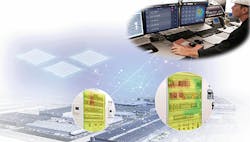To understand the benefits of advanced power supplies, we must first understand what a switched-mode power supply (SMPS) is and how it works. The SMPS is designed to take power from an ac or dc source and convert it to a dc load to power devices inside a control panel. The SMPS performs this duty by using a switching regulator to convert voltage and current from one type to another, so it can power the devices inside the control panel.
An example of this is a power supply that converts standard 115 Vac into 24 Vdc to power a device such as a timer or counter that requires 24 Vdc. In this instance, the device needing power is not compatible with the standard ac power being supplied, so a switched-mode power supply is required to convert the voltage and current into a form that can be used by the device.
Also read: Power Supplies Get Smarter
A reliable power-supply system in the control panel starts with predictive-maintenance (PdM) features and Ethernet connectivity. Adopt a redundancy setup for your most critical power supplies. This would have two power supplies connected in parallel with a redundancy controller, so the secondary power supply can step in if the primary power supply fails. In addition to a redundancy setup, any critical system should have backup power in the form of an uninterruptible power supply (UPS), which is a battery backup system designed to provide power to the devices in your control panel in the event that a power outage or power-supply failure occurs. This allows you to continue powering essential items like an industrial PC or PLC so your equipment can be safely shut down, as opposed to being abruptly shut off.
For automotive plants seeking to improve productivity and reduce downtime, PdM is essential, particularly when it comes to power supplies. Unexpected power-supply failures can impact vehicle production and assembly, and continuously monitoring power-supply condition can predict impending failure.
PdM is more important for automated processes than it is for manual ones in automotive manufacturing because potential losses are typically higher with automated processes. A majority of the production from Tier 1 suppliers is done just in time (JIT), so a supplier’s inoperative production line also will impact the automotive manufacturer.
The combined effect of age and heat is the most common cause of a power-supply failure. Deterioration of the capacitors inside the power supply ultimately makes it unable to provide clean, stable power within its original specifications. Other issues that can cause a power supply to fail are environmental, such as the presence of moisture, dust or other particulates in the air that get into the device and cause corrosion. Most power supplies will carry an ingress-protection (IP) rating that indicates the degree of protection the unit has from the surrounding environment. There are two main types of protection indicated in an IP rating. The first is protection against physical objects, and the second is protection against liquids. Most modern power supplies have a protection rating of at least IP20. The first number, 2, tells us the unit is protected against penetration of small objects larger than 12.5 mm in diameter. The second number, 0, tells us the unit has no protection against water, which is not uncommon for power supplies that are contained within a control panel. As these numbers increase, the level of protection increases for its respective category. Other factors that determine the life of a power supply include power surges, transients, induced power-line surges, lightning strikes and reactive loads. These issues will reduce the life of a power supply or cause it to fail depending on the severity.
Plant workers are unable to identify and troubleshoot abnormalities in aging power supplies for plastic-forming-equipment components if they’re lacking remote-monitoring capabilities. Monitoring enables plants to arrange maintenance more effectively, eliminating unexpected downtime and premature replacement of power supplies.
Using a power supply with PdM features will allow you to monitor its health. Beyond this, a power-supply redundancy controller can help by having a backup power supply ready. And it’s a good practice to have additional power supplies in stock to replace a failed one.
A remote-monitoring solution offered by PdM technology provides power-supply health information, including voltage, current and peak current to help identify abnormal dc circuit issues without requiring personnel to open the panel. Data can be transmitted via Ethernet cable to a PC on the local network so the maintenance staff can monitor its health. PdM is designed to reduce the burden of frequent inspections and unexpected downtime by allowing maintenance staff to know exactly how their power supplies are performing and schedule maintenance or replacement when it’s most convenient.
In addition to data and graphs provided by an Ethernet-connected power supply with PdM technology, power-supply status can be checked on a derating chart and to simulate capacity changes.
Based on what we know about how power supplies fail—capacitors deteriorate with time and heat—keeping your control panel properly cooled with adequate airflow will reduce the ambient temperature and help your power supply run cooler.
Be sure to use the right power supply for the operating environment. If the panel is in a harsh environment, you will want to select a power supply with a coated PCB to help protect the electronic components from moisture, dust and other particles that could cause corrosion. And be sure to have good clean and stable power coming into the power supply. If your input power is not clean, install a noise filter to reduce the chances that transient energy will degrade the components within your power supply.
Matt Mohr is product manager, component, at Omron Automation. Contact him/her at [email protected].
About the Author
Matt Mohr
Omron Automation

Leaders relevant to this article:

